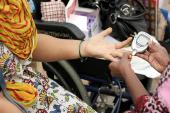Indian Patients Do Well on Dual-Combination Pills for Hypertension: TOPSPIN
The India-based trial, the first of its kind, confirmed that systolic BP levels decreased no matter the exact mix of three drug classes.

CHICAGO, IL—For hypertensive patients, dual-combination therapies taken as a single pill are similarly effective, safe, and well tolerated irrespective of their exact mix of an ACE inhibitor, calcium channel blocker, or diuretic, according to results from the randomized TOPSPIN trial. Over 70% of patients treated were able to get their blood pressure under 140/90 mm Hg.
Dorairaj Prabhakaran, MD, DM, and Dimple Kondal, PhD (Centre for Chronic Disease Control, New Delhi, India), presented results from the Indian trial here last weekend at the American Heart Association (AHA) 2024 Scientific Sessions.
“In India, there are 300 million people living with hypertension, but the control rates are abysmal,” at around 7-11% in rural areas and 11-20% in urban areas, Prabhakaran told the media during an AHA press conference.
Most clinical guidelines, he noted, currently call for initiation of two antihypertensive drugs, which can be chosen from three drug classes: renin-angiotensin-system blockers, calcium channel blockers, and diuretics. Importantly, though, before TOPSPIN, there had not yet been a randomized trial done specifically in India to address the best initial dual therapy for hypertension management.
Shawna D. Nesbitt, MD (UT Southwestern Medical Center, Dallas, TX), at the media briefing, highlighted the fact that while the number of adults with hypertension rose by 41% from 1990 to 2019 in Europe and the Americas, the number shot up by 144% during the same period in Southeast Asia and the Western Pacific. “This is a dramatic increase,” she stressed, agreeing with the need to perform an India-based trial.
TOPSPIN
TOPSPIN enrolled 1,981 patients ages 30 to 79 (mean age 52.1 years; 42.1% female) with sitting office systolic BP 140-159 mm Hg on one antihypertensive agent, or 150-179 mm Hg on no treatment. Patients were randomized to one of three daily single-pill combinations at starting doses: amlodipine plus perindopril, amlodipine plus indapamide, or perindopril plus indapamide. All reached full doses at 2 months unless their systolic BP was < 120 mm Hg. Baseline characteristics were similar across the treatment groups.
Mean change in 24-hour ambulatory systolic BP at 6 months, the primary endpoint, was similar with amlodipine plus perindopril (-14.5 mm Hg), amlodipine plus indapamide (-13.9 mm Hg), and perindopril plus indapamide (-13.3 mm Hg). In each group, over 40% of patients achieved a systolic BP of < 130/80 mm Hg and more than 70% had a systolic BP of < 140/90 mm Hg. In all, 51 individuals (2.6%) stopped taking their assigned medication due to typical adverse events associated with the drugs.
The results, said Prabhakaran, are in line with current guidelines that allow for choice among antihypertensive drugs.
Nesbitt, for her part, pointed out that the various drug regimens in TOPSPIN were not only effective and safe, but also well tolerated. Fixed-dose combinations, as suggested by earlier studies, “may facilitate higher adherence to therapy and more efficient achievement of BP goals” in India, she added, though clinicians need additional options for dosing and clarity on how to individualize treatment.
Also, “cost and availability must be considered when using combination therapy,” Nesbitt said.
Speaking with TCTMD, Prabhakaran elaborated on the numerous barriers that stand in the way of patients in India getting necessary treatment for high blood pressure. “The most important reason, I think, is low awareness. Second, there are no screening programs,” he explained, adding that because hypertension often lacks symptoms, it may go unnoticed. Many people, too, are hesitant to get a diagnosis out of “fear they will have to take the drugs lifelong, which is true.”
Misinformation on social media also plays a role, as does clinician inertia. And finally, there’s the gap between rural and urban populations, which can impair access to healthcare, as well as the difficulty some may have in affording antihypertensive drugs, Prabhakaran noted.
Caitlin E. Cox is News Editor of TCTMD and Associate Director, Editorial Content at the Cardiovascular Research Foundation. She produces the…
Read Full BioSources
Prabhakaran D, Kondal D. TOPSPIN – a randomized trial comparing three dual-therapies for hypertension treatment among Indians. Presented at: AHA 2024. November 17, 2024. Chicago, IL.
Disclosures
- Servier supported the study with an unrestricted educational grant and in-kind logistical support.
- Prabhakaran and Kondal report having no relevant conflicts of interest.
- Nesbitt reports serving as a site investigator for a clinical trial by Ablative Solutions.





Comments